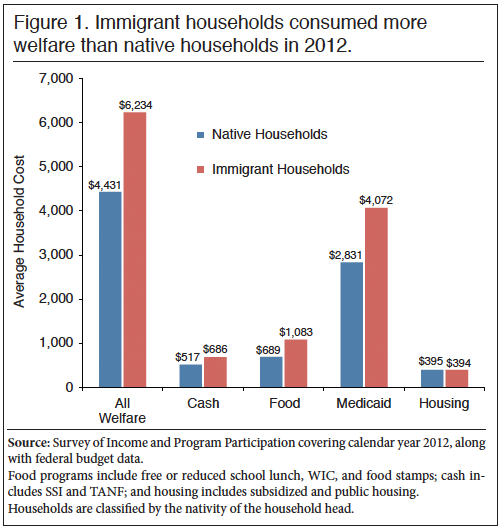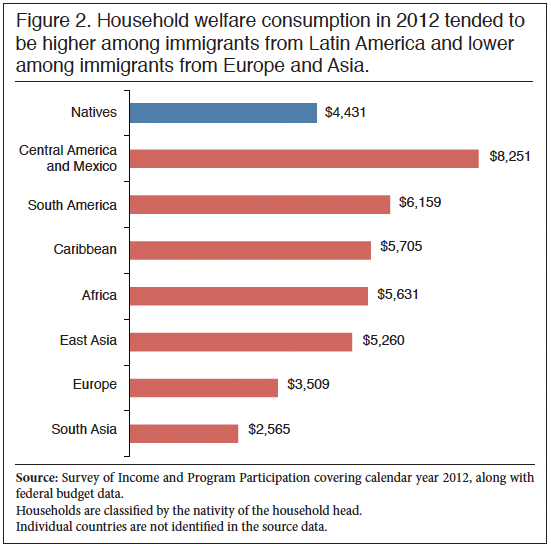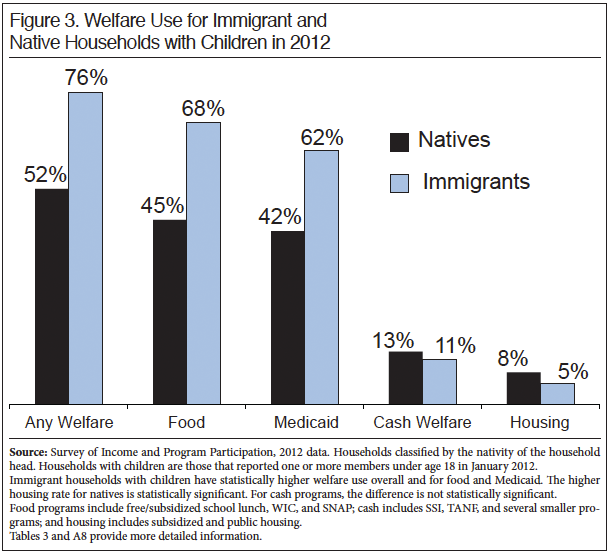"Legit immigration" is a major problem in terms of numbers and costs. We take in too many legal immigrants, 1.1 million a year. Since 1990 we have brought in 35 million, which is equivalent to the population of Canada. We have just had three of the four highest decades of legal immigration in our history.

LEGAL IMMIGRANTS use the welfare system to a much greater extent than the native born. Taxpayers are picking up the tab. Over ten years ago Robert Rector of the Heritage Foundation wrote a seminal paper on it. Importing Poverty: Immigration and Poverty in the United States: A Book of Charts
In 1963, President Lyndon Johnson launched the War on poverty with the goal of eliminating poverty in the United States. Since that time, the U.S. has spent over $11 trillion on anti-poverty programs, providing cash, food, housing, medical care, and services to the poor and near poor. Today, government provides a generous system of benefits and services to both the working and non-working poor. While government continues its massive efforts to reduce poverty, immigration policy in the U.S. has come to operate in the opposite direction, increasing rather than decreasing poverty. Immigrants with low skill levels have a high probability of both poverty and receipt of welfare benefits and services.[1]
Since the immigration reforms of the 1960s, the U.S. has imported poverty through immigration policies that permitted and encouraged the entry and residence of millions of low-skill immigrants into the nation. Low-skill immigrants tend to be poor and to have children who, in turn, add to America's poverty problem, driving up governmental welfare, social service, and education costs.
Today's immigrants differ greatly from historic immigrant populations. Prior to 1960, immigrants to the U.S. had education levels that were similar to those of the non-immigrant workforce and earned wages that were, on average, higher than those of non-immigrant workers. Since the mid-1960s, however, the education levels of new immigrants have plunged relative to non-immigrants; consequently, the average wages of immigrants are now well below those of the non-immigrant population. Recent immigrants increasingly occupy the low end of the U.S. socio-economic spectrum.
The current influx of poorly educated immigrants is the result of two factors: first, a legal immigration system that favors kinship ties over skills and education; and second, a permissive attitude toward illegal immigration that has led to lax border enforcement and non-enforcement of the laws that prohibit the employment of illegal immigrants. In recent years, these factors have produced an inflow of some ten and a half million immigrants who lack a high school education. In terms of increased poverty and expanded government expenditure, this importation of poorly educated immigrants has had roughly the same effect as the addition of ten and a half million native-born high school drop-outs."
Today's immigrants are not assimilating due to the large numbers. The overwhelming majority are minorities who are encouraged to identify as a minority to obtain various government benefits and perks. They also adopt inimical views of the white majority whom some consider oppressors. They don't identify with the vision of our Founders whom some consider as racists and bigots.


In 2012, 51 percent of households headed by an immigrant (legal or illegal) reported that they used at least one welfare program during the year, compared to 30 percent of native households. Welfare in this study includes Medicaid and cash, food, and housing programs.
Welfare use is high for both new arrivals and well-established immigrants. Of households headed by immigrants who have been in the country for more than two decades, 48 percent access welfare.
No single program explains immigrants' higher overall welfare use. For example, not counting subsidized school lunch, welfare use is still 46 percent for immigrants and 28 percent for natives. Not counting Medicaid, welfare use is 44 percent for immigrants and 26 percent for natives.
Immigrant households have much higher use of food programs (40 percent vs. 22 percent for natives) and Medicaid (42 percent vs. 23 percent). Immigrant use of cash programs is somewhat higher than natives (12 percent vs. 10 percent) and use of housing programs is similar to natives.
Welfare use varies among immigrant groups. Households headed by immigrants from Central America and Mexico (73 percent), the Caribbean (51 percent), and Africa (48 percent) have the highest overall welfare use. Those from East Asia (32 percent), Europe (26 percent), and South Asia (17 percent) have the lowest.
